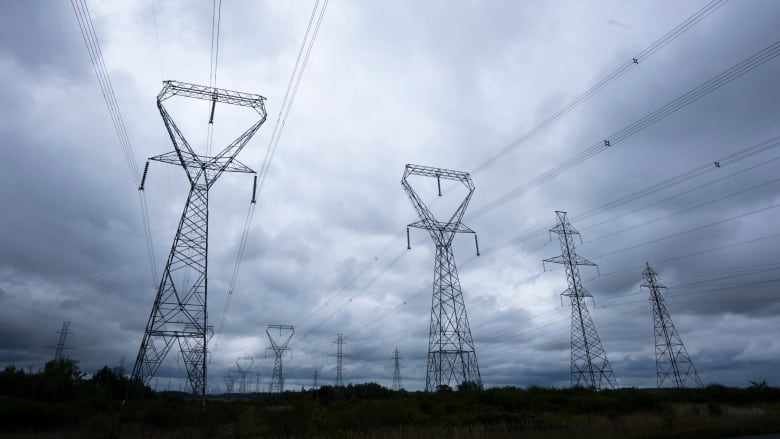Manitoba plans to use wind power to double or triple energy-generating capacity over next 2 decades
Future hydro-electric dams likely too costly, despite growing demand for electricity

Manitoba says it needs to double or triple its electricity-generating capacity over the next two decades and it won't build new hydroelectric dams to meet that goal.
The province plans to rely on wind farms and other forms of green powerto boost generating capacity from 6,600 megawatts right now to somewhere between 10,000 and 16,000 megawatts by the 2040s, according to a new energy policy announced on Friday.
A growing demand for cleaner energy has increased demand for hydroelectric power and that demand is set to rise as more companies phase out natural gas and petroleum products, Manitoba Hydro board chair Edward Kennedy told reporters outside the Crown corporation's downtown Winnipeg headquarters.
This will force Hydro to increase its generating capacity and save more power. On the generation front, Hydro expects to rely primarily on wind power, likely by purchasing from private companies and then selling itto consumersand industrial customers.
Premier Heather Stefanson said this does not mean Manitoba Hydro is for sale.
"Manitoba Hydro will remain the sole energy provider for Manitoba. That means any private providers will always need to sell power to Hydro and rates will always be set by the Public Utilities Board," Stefanson said at the same news conference.
Sandy Riley, a former Manitoba Hydro board chair who is assisting the province with its energy policy, said Manitoba did not invest in wind power in the past because it possessedan excess of generating capacity.
That's no longer the case and there is no prospect of engaging in new hydroelectric megaprojects.The high cost of Hydro's most recently completed generating station, Keeyask on the Nelson River, makes future investments in dams highly unlikely, Kennedy said.
"That last generating station exceeded the cost of the book value of all of our other generating stations combined but created only 11 per cent more capacity and doubled the debt of Manitoba Hydro to $22 billion," he said.
On the savings front, Hydro said it will explore the useof battery storage to even out the high winterdemand for power with the lower summer demands.
The new energy policy also calls forManitoba Hydro toutilize"smart meters" that could chargeconsumers lower rates for power during off-peak hours.
NDPLeader Wab Kinew criticized this idea, characterizing it as "surge pricing."

The province's new energy strategy also calls for major investments in electricity transmission and distribution, as well as the careful selection of new industrial developments that use electricity.
Right now, the province is considering 18 energy-intensive industrial proposals that together would require 4,400 megawatts of power.
As a result, the province will give preference to industrial proposalsthat provide the greatest economic benefit as well as the lowest environmental impact.
"It will require a lot of nimble, careful selection of technology and investment," Kennedy said.
$3Bsolar-panel manufacturing campus
One of those proposals already favoured by the province is a plan by Germanmanufacturer RCT Solutions to build a $3-billion solar panel production campus near Winnipeg.
It would employ 8,000 people and produce enough panels to generate10 gigawatts of power that is, 10,000 megawattseveryyear.
RCT founder Peter Fath said the campus would be built out in stages, likely at a site or sites close to Winnipeg,and would eventually be poweredby the panels it manufactures.
He said Manitoba is attractive because it offers carbon-neutral hydroelectric power, a lot of annual sunshine, good logistics for shipping and an abundance of ultrapure silica sand, the raw material for solar panels.
The province, however, has yet to approve a proposal by Calgary mining companySio Silica to drill below the surface for this sand. Fath said other North Americanjurisdictions would compete with Manitoba for this plant if sand mining does not go ahead here.
"Our preferred choice is Manitoba and I'm totally positive that the Manitoba government, which is so supportive, will find a way to clear thislicensingissue," Fathsaid Friday in a telephoneinterview from Boston.
The province signed a memorandum of understanding with RCT Solutions earlier this week. Environment and Climate Minister Kevin Klein said that does not increase pressure on him to approve Sio Silica's proposal.
The Clean Environmental Commission, Manitoba's environmental regulator, raised concerns in June that sand extraction could diminish the quality of water in an aquifer that serves as a source of drinking water for tens of thousands of Manitobans.
SioSilica CEO Feisal Somji said in an interview he hopes those concerns can be addressed in a licence that would requirehis firm to demonstrate, via testing, that its sand-extraction methods do not haveadverse effects on drinking water.
The new energy policy also said the cost of making Manitoba's electricity generation entirely free of greenhouse gas emissions right now, it's97 per cent emissions-free would be inordinately expensive. Some natural gas will continue to be used in the coming decades, it envisioned.
Curt Hull, project director at Climate Change Connection, said the plan ought to envision an entirely electric future.
With files from Victor Lhoest and Ian Froese













_(720p).jpg)


 OFFICIAL HD MUSIC VIDEO.jpg)
.jpg)



























































































